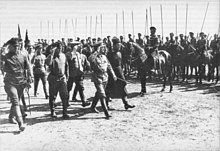
Back الغزو السوفيتي لأوكرانيا عام 1919 Arabic Invasion soviétique de l'Ukraine French Interwencja radziecka na Ukrainie (1919) Polish Наступление Украинского фронта Russian Украин фронты һөжүме Tatar Радянське вторгнення в Україну (січень-червень 1919) Ukrainian 1919年苏俄入侵乌克兰 Chinese
The Soviet invasion of Ukraine was a major offensive by the Ukrainian Front of the Red Army against the Ukrainian People's Republic (UPR) during the Soviet–Ukrainian War. The invasion was first planned in November 1918, after the Council of People's Commissars of the Russian Soviet Federative Socialist Republic annulled the Treaty of Brest-Litovsk, and was launched in the first days of January 1919, with the occupation of Kharkiv. Its aim was to join Ukraine to the RSFSR, as the country was of significant economic, demographic and strategic importance for the Bolsheviks. In the longer term, the capture of the Black Sea coast was to prevent an intervention by the Allies in support of the Volunteer Army. Finally, the Bolsheviks intended to extend the area they control as far as possible to the west, in order to be able to support the other revolutionary movements in Europe.
In the first days of January 1919, by joining forces with local workers' units, the troops of the 1st Ukrainian Soviet Division took Kharkiv, which was announced as the seat of the Provisional Workers' and Peasants' Government of Ukraine. Then they quickly captured most of northern and eastern Ukraine, and on 5 February 1919, they occupied Kyiv. The Directorate of Ukraine moved to Vinnytsia, then to Kamianets-Podilskyi. By spring, the Red Army had reached the Zbruch and repelled a counteroffensive by the Ukrainian People's Army (UPA) that threatened Kyiv.
The introduction of the policy of war communism and the requisitioning of food for the needs of the cities quickly alienated a significant part of the Ukrainian peasantry from Bolshevik rule. The outbreak of a number of local uprisings, and in May 1919, the rebellion of the 20,000-strong forces of Nykyfor Hryhoriv, prevented the Red Army from finally destroying the UPA and marching west towards Bessarabia and Hungary. At the end of June, the Red Army suffered a series of defeats in clashes with the Volunteer Army in Donbas, losing Katerynoslav and Poltava by the end of June 1919, as well as those territories captured in the course of operations against Mykolaiv and Odesa. In August, the Red Army also succumbed to the offensive of the combined forces of the Ukrainian People's Army and the Ukrainian Galician Army. On 31 August, Kyiv was captured, first by the Ukrainian People's Army, and then, after their withdrawal from the city, by the Volunteer Army.[1]
- ^ Kenez 2004, p. 154.
© MMXXIII Rich X Search. We shall prevail. All rights reserved. Rich X Search
